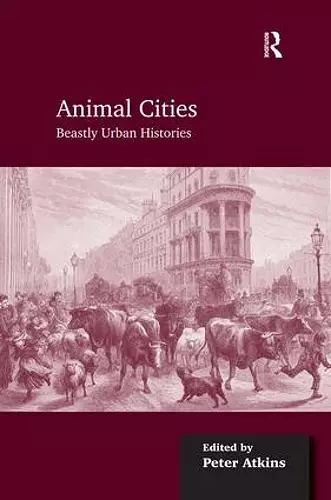Animal Cities
Beastly Urban Histories
Format:Hardback
Publisher:Taylor & Francis Ltd
Published:12th Sep '12
Currently unavailable, and unfortunately no date known when it will be back
This hardback is available in another edition too:
- Paperback£51.99(9781138247031)

Animal Cities builds upon a recent surge of interest about animals in the urban context. Considering animals in urban settings is now a firmly established area of study and this book presents a number of valuable case studies that illustrate some of the perspectives that may be adopted. Having an ’urban history’ flavour, the book follows a fourfold agenda. First, the opening chapters look at working and productive animals that lived and died in nineteenth-century cities such as London, Edinburgh and Paris. The argument here is that their presence yields insights into evolving understandings of the category ’urban’ and what made a good city. Second, there is a consideration of nineteenth-century animal spectacles, which influenced contemporary interpretations of the urban experience. Third, the theme of contested animal spaces in the city is explored further with regard to backyard chickens in suburban Australia. Finally, there is discussion of the problem of the public companion animal and its role in changing attitudes to public space, illustrated with a chapter on dog-walking in Victorian and Edwardian London. Animal Cities makes a significant contribution to animal studies and is of interest to historical geographers, urban, cultural, social and economic historians and historians of policy and planning.
'Animal Cities provides a valuable introduction to the growing field of animal history. Its nine essays explore a variety of issues relating to animals in an urban context, connected their presence or exclusion to the changing culture and fabric of the city. All of the essays are worth reading, but those of Atkins, constituting half of those in the volume, are especially penetrating. I strongly recommend the book to urban and environmental historians.' Joel Tarr, Carnegie Mellon University, USA 'Animal Cities offers an important contribution to a neglected field of study, opening up an array of questions that deserve further attention. It positions animals not as peripheral participants of the city, but as central to historical stages of urbanisation. Most importantly, the history of our changing relationships with productive animals raises questions about how we define the good city today.' LSE Review of Books '... this volume has much to recommend it. It provides a wealth of data into the role and presence of animals in nineteenth-century British, French, and Australian cities, and offers insight into how and why animal populations decreased. It therefore makes an important contribution to urban geography and urban environmental history.' H-Urban/H-Net 'Animal Cities provides a useful extension of geographical scholarship on animals in the urban context. This book is a welcome addition to geography’s many branches, not only historical, animal, and urban, but also the geography of political economy and political ecology.' Journal of Historical Geography 'The authors’ detailed historical analyses also raise important questions as to how and where animals should coexist with people in the city of today and the future. These questions become ever more salient as the world’s cities continue to grow.' Environmental History 'One of the most commendable aspects of Animal Cities is its minimal use of academic jargon ...it will appeal primarily to urban and envir
ISBN: 9781409446552
Dimensions: unknown
Weight: 453g
294 pages